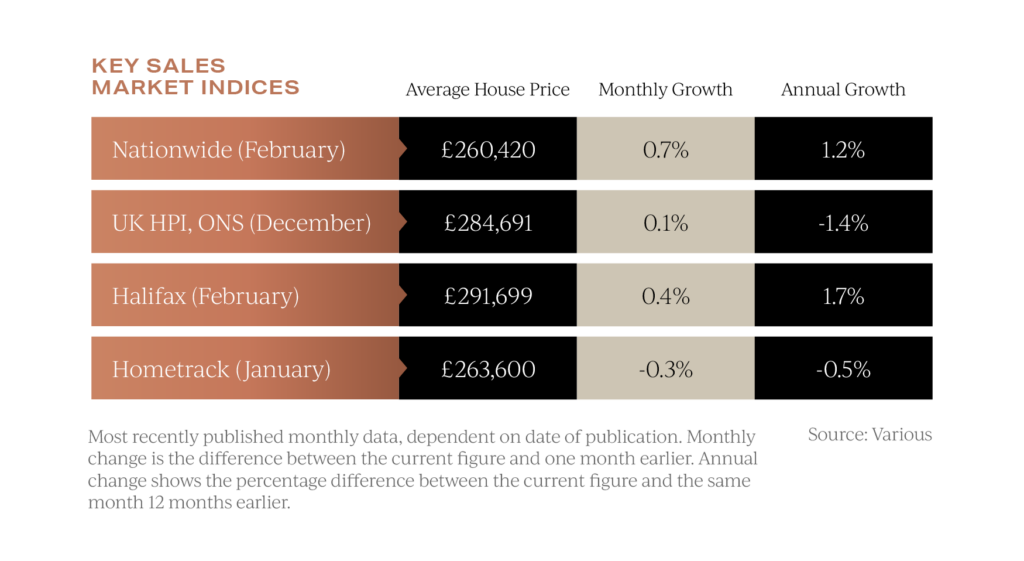Welcome to the April edition of Garrington’s UK Property Market Review. As spring unfolds, the property market enters a...

UK Property News – March 2024
Welcome to the March 2024 edition of Garrington’s UK property market review.
The start of meteorological spring hasn’t yet created a profound difference in the weather and the same could be said for the property market.
The headline pattern of improving conditions remains, but market activity is patchy and volatile in many parts of the UK.
Agreed property sale transactions have improved by 15% compared to the same period a year ago. London and the North East of England are enjoying the highest rates of increased activity, with the West Midlands seeing the lowest jump in agreed transactions according to Hometrack. The 4th of March saw the highest number of exchanges in a day for 11 years at the upper end of the central London market for properties of £5million and above.
The 4th of March saw the highest number of exchanges in a day for 11 years at the upper end of the central London market for properties of £5million and above.
Average UK house prices continued to climb last month, with both Nationwide and Halifax reporting monthly gains of 0.7% and 0.4% respectively. Halifax reports that this is the fifth consecutive month of UK property average price rises.

Data and headlines such as these are helping confidence levels as the market slowly turns a corner. However, it remains a price-sensitive buyers’ market in many locations.
Budget reaction
The recent Spring Budget contained no significant policy announcements to support the market. However, certain policy announcements will be felt by some groups of property buyers and owners.
For example, multi-generational property buyers, and prime buyers acquiring significant properties with independent ancillary accommodation, learnt of the withdrawal of Multiple Dwellings Relief on Stamp Duty Land Tax in England and Northern Ireland, which will be unwelcome news.
The relief will be abolished from 1st June 2024, but investors buying six or more properties will be assessed using non-residential rates of SDLT.
The holiday changeover
The Budget announcement of the removal of the tax incentives for furnished holiday lettings from next April looks short-sighted in the extreme.
It is likely to trigger a flurry of owners exiting from the sector, thus harming tourism and local jobs in the process.
Switching to conventional rentals will typically not work for these investors as owning property in a private name is not tax efficient, and frequently, holiday homes are not the types of property well suited for traditional lettings.
For existing financially weary landlords in the private rental sector, who own assets in their private names, an improving sales market and lower Capital Gains Tax bills from property sales may become the ‘starter-gun’ to see more stock leave the sector.
It could be argued that this will supress house prices and give more choice to first time buyers, but this will do nothing to calm rental inflation levels with a diminishing pool of available homes to rent.
With an average of over 40 tenants chasing each newly listed rental property, the last thing the sector needed at the moment was encouragement for landlords to sell up and leave.
Sadly, the Budget has done little to help the parts of the market that needed it most.
Turning threats into opportunities
One of the consequences of a supply-restricted rental market has been dramatic rent price increases across many parts of the UK property market.
Indicative gross yields remain attractive in the rental market. Based on an analysis of apartments sold and rented in 2023, the indicative gross yield is 6.7%. This is up from 5.3% in 2021.

Yields are currently strongest in the north-west at 8.5% and rental growth is forecast to outpace the sales market over this year, with a forecast rise of 5%.
Against a backdrop of projected interest rate falls later this year, sophisticated investors are showing renewed interest in investment property.
This profile of buyer differs significantly from that of the traditional landlord. Typically, they are acquiring high-quality property to be professionally managed as a passive investment, owned through a special purchasing vehicle for the long term.
This profile of investor is common in many European countries, together with family offices and institutions, and may well become the new norm in the UK’s private rental sector over time.
A mixed outlook for UK property
Lower inflation forecasts are good news for interest rates. The Office for Budget Responsibility (OBR) forecasts inflation will go below 2% in a few months’ time.
Throughout the Budget there was a strong focus on growth sectors like green industries, tech and life sciences.
The government’s decision to abolish the current tax system for non-doms is predicted to hinder inward investment into the UK and remove the attractiveness of locations such as London.
The OBR has estimated that 10 to 20% of non-doms will leave the UK because of the changes.
The true impact of the Budget announcements will only be clear in the UK property market and wider economy over time. For now, the outlook remains cautiously optimistic.
With news that the UK economy has returned to modest growth at the start of the year, property transactions are expected to continue to gain traction as we enter the traditionally busier spring market.
If you are considering your moving options, don’t forget to visit Garrington’s Best Places to Live research to see our guide and interactive location explorer.
As ever, if you are contemplating a property purchase this year and would like some expert guidance, do contact us to learn how Garrington can assist you.









